
The past few years have seen many innovations in the world of mobile marketing, one of the biggest being the use of digital barcodes. Digital barcodes, or Quick Response codes, are barcodes that, when scanned using a mobile device’s QR code reader, lead users to promotional information designated by the creator. We believe digital barcodes will help mobile marketing finally break into the mainstream. They create a more intimate experience for users as well as increase the effectiveness and response time of opt-in marketing campaigns.
The biggest advantage to a digital barcode campaign is an increase in user engagement. Digital barcodes create a more enticing, personal experience for users that is hard to replicate in other mediums. They also have the ability to quickly show the success of a campaign based on the number of scans per location, which can be measured at any time. Additionally, digital barcodes can drive quality traffic to a company’s website or landing page, allowing for targeted marketing. Finally, consumers that use the bar codes are showing an immediate interest, making it easier for companies to get visitors to interact with their product or service.
This is perfectly demonstrated by a digital barcode campaign that was recently launched by Calvin Klein to support their new lines of X jeans. Billboards were placed in New York and Los Angeles with a digital barcode on them in place of the normally racy billboard. If scanned, the ad promised an uncensored version for private viewing. With the campaign, Calvin Klein enticed consumers to visit its site under their own volition and to engage with their new product in influencer markets.
QR Codes have also been used for other types of campaigns. The nonprofit group Women of the Storm used digital barcodes to rally support for restoration of the Gulf Coast after the BP oil spill. The Be the One Campaign, with the assistance of ScanLife, created a digital barcode that leads to their website. This barcode was then put on display in Times Square as well as printed on stickers and T-shirts. To date, it has resulted in over 120,000 people signing up to support their cause.
While there are many advantages to a digital barcode campaign, there are some drawbacks to be considered. The technology is still very new and in most cases requires a smartphone. Marketers will also need to make sure they have a significant web presence. With this type of campaign, companies must ensure that consumers will remain engaged once they hit the landing page or the campaign is destined to fail.
This technology is an exciting look into the future of marketing. We are currently utilizing one on our building for our Google business listing and believe that digital barcodes offer many options for engaging the audience with creative, versatile opt-in marketing campaigns. While there are still some issues to work around, this technology offers the ability take mobile marketing to a whole new level.
If you or your company is interested in learning more about the potential for digital barcode campaigns, please contact Michael Garten by phone (949.698.2983), on Twitter or through Linkedin.